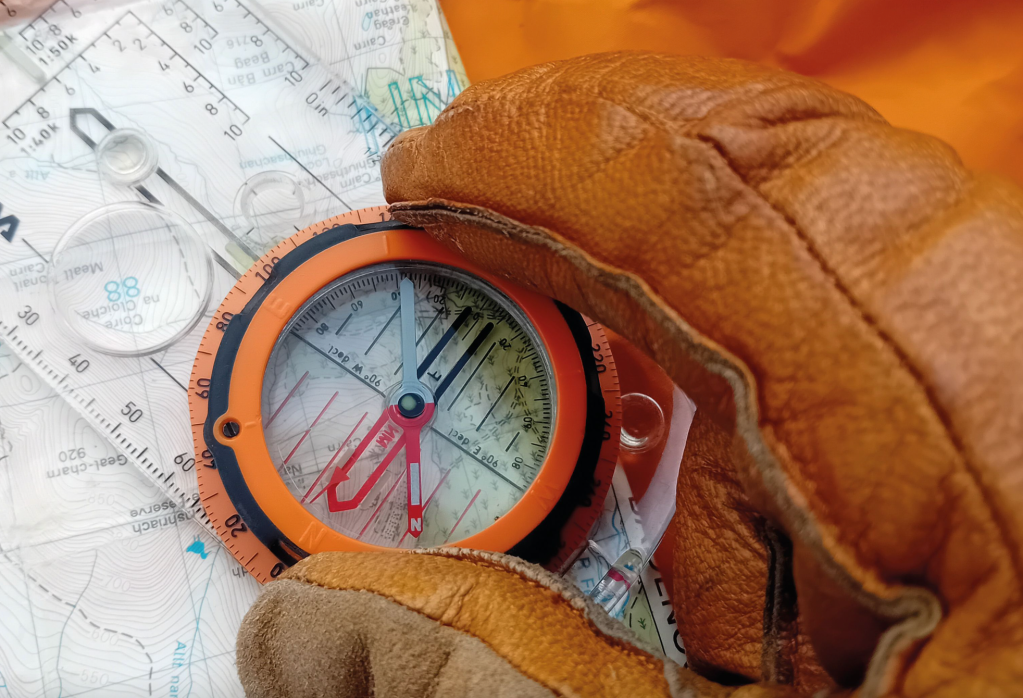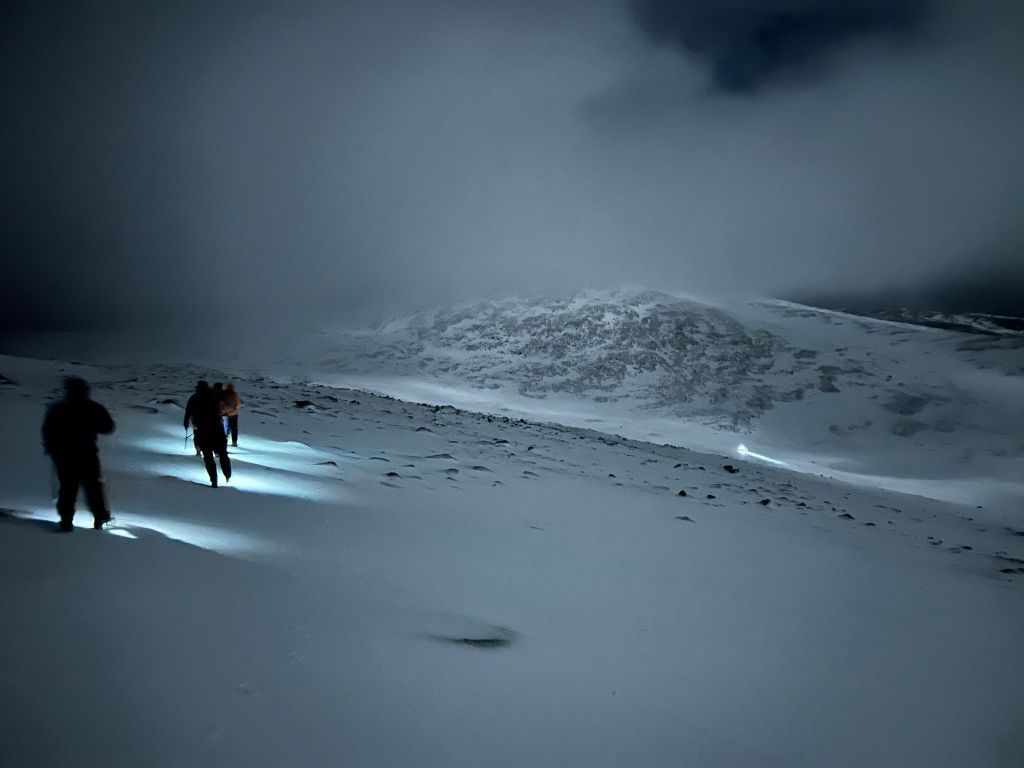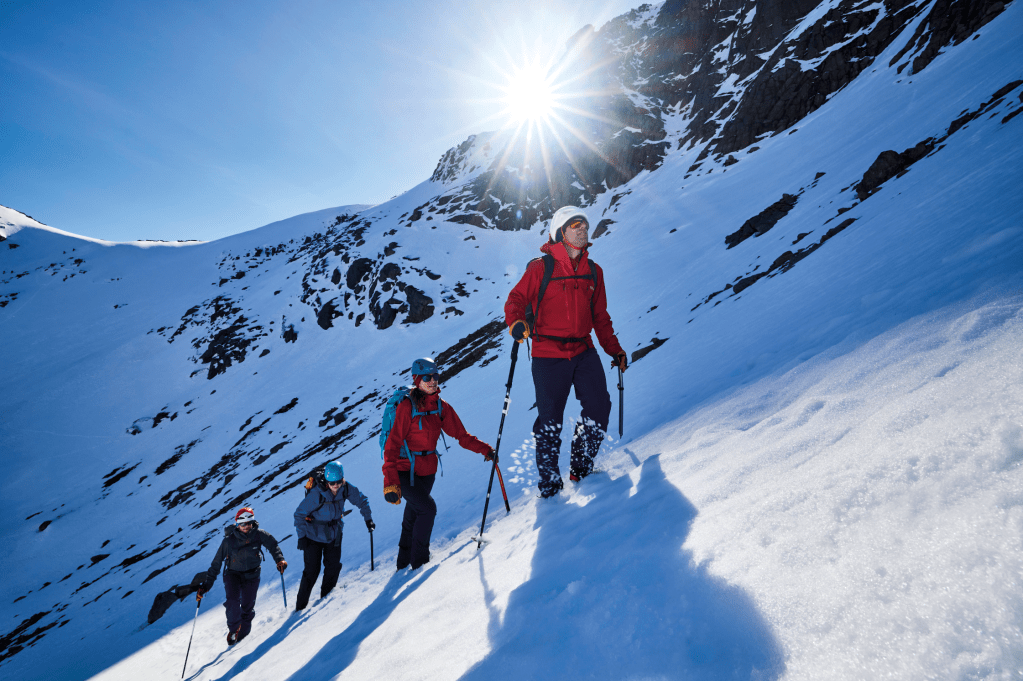Glenmore Lodge Instructor Scott Brookes shines a light on winter night navigation as the days draw in.
There are many skills that allow us to safely enjoy the mountains in winter, but solid night navigation is the cornerstone—essential for getting on and off the hill safely. It’s unlikely that you’re nocturnal and fancy heading out Munro bagging in the middle of the night, but in Scottish winter, you’ll often start your day in darkness and finish it in the dark. The days are short, and knowing how to navigate safely in low light or total darkness is essential.
Main image: Be prepared to start and end your day in darkness | Credit: Scott Brookes
How to master night navigation
The Gear
Head torch
A good head torch is essential, and you’ll want one that’s bright enough to light up the terrain—around 900 lumens is ideal. Choose a head torch with different power settings to save battery life, and so it’s not so bright that it blinds you when checking the map or reflects too much off the snow.

Ensure you can use your compass with your winter gloves. Credit: Scott Brookes
Compass
This small piece of equipment is vital for navigating in winter. Invest in a quality compass from a recognised brand. It may seem expensive for what it is, but if you take care of it, a good compass will last and can keep you safe. Make sure to practice using it while wearing your large winter gloves to ensure compatibility.
I prefer a compass with a rubber bezel, a large base plate, and rubber pads to help it stay put on your map case when taking a bearing. Also, ensure that the compass has a scale compatible with your map. In the UK, the main map scales are 1:25k, 1:50k, and 1:40k, so make sure your compass has these scales to avoid any unnecessary calculations in challenging conditions.
Map and case
Your map is useless if it’s buried in your rucksack. Use a small A5 map case that fits in a jacket pocket for quick reference. Attach it via a short cord to your zipper toggle—this prevents the wind from snatching it away. Map scale is a personal preference and depends on the terrain. I often use small, printed maps at 1:50k and 1:25k scales, placing them back-to-back in the case so I can reference both. For winter, a good compromise is the Harvey 1:40k. Printing out OS Landranger maps at Explorer scale gives you a less cluttered view with the finer details highlighted.
Stopwatch
Keeping track of time in winter is crucial, not only for general navigation but also for measuring distances travelled. A watch buried under layers of clothing is inconvenient, and risks exposing your skin to freezing conditions. Attaching your watch to your wrist over your jacket or, better yet, securing a dedicated watch to your rucksack’s shoulder strap is much more practical.

Ensure you have the right kit before heading out at night. Credit: Scott Brookes
Goggles
Often overlooked, ski goggles are crucial in winter, especially when navigating at night. Double-lens ski goggles work best, I recommend clear lenses.
Electronics
Having a GPS device or a mobile phone with mapping software is useful. Be mindful that over-reliance on electronics has led to accidents, but when used alongside traditional tools, they can boost your confidence and improve navigation.
Your phone, most likely your primary contact to the outside world in case of emergency, needs to have its battery life conserved. You can do this by switching your phone to airplane mode, keeping your phone close to your core in a secure pocket, storing it in a weatherproof case and carry a small power bank and cable as backup. Use your phone to check and confirm location, then refer to your map and compass. Make sure you have mapping software that works offline and you have downloaded the area you are visiting.

You can’t always guarantee the light of the moon. Credit: Scott Brookes
The Skills
Winter navigation at night demands focus and regular practice. You’ll be building on your summer navigation skills, but some winter-specific adaptations are necessary.
Destination
Be realistic about your destination and the features you’re navigating towards. Freezing temperatures and whiteout conditions are not the time to search for small, intricate contour line. Instead, aim for more obvious features like gradient changes, slope aspects, or other prominent features. Avoid features that may be snow covered, such as path junctions, that may no longer be visible.
Strategy
Develop a clear strategy for reaching your destination. Here are some helpful questions to ask yourself:
- Are there features, like ridgelines or re-entrants, that I can follow as “handrails”?
- Are there attack points to break up longer navigation legs?
- What are my catching features such as physical gradient changes
- Do I need a compass bearing? (The answer to this is most likely a yes.)

Varying weather conditions can change the look of the landscape. Credit: Scott Brookes
Design/Description
Take the time to fully understand the information on your map and imagine what the route will look and feel like. Again, here are some helpful considerations:
- Be precise as possible when taking compass bearings.
- How far is the leg? How long will it take?
- What will the terrain feel like? Will I be ascending, descending, or traversing a slope?
- Are there specific areas to avoid due to efficiency or hazards like cornices or avalanche hazard?
The above process should be continuous, with adjustments as you work through it. With regular practice, your winter night navigation will become more streamlined, and the process won’t feel time-consuming.
The Practice
The great thing about navigation is that you can practice it almost anywhere. You don’t need to be on the Cairngorm plateau in the dead of night to develop these skills, but eventually, you’ll want to contextualize them in the winter mountains. I like to think of practice in two elements: terrain and weather.
Here’s a gradual approach to building your skills:
- Practice in a familiar area at night with good weather.
- Practice in a familiar area in slightly more challenging weather (e.g., wind or low cloud).
- Navigate in an unfamiliar area with good weather.
- Eventually, test your skills in unfamiliar areas in challenging weather conditions.
With practice and preparation, winter night navigation will become second nature. By honing your skills, you can safely enjoy the magic and challenge of the Scottish winter mountains.

On a Glenmore Lodge winter skills course. Credit: Ed Smith
Scott’s Top Tips
- Create a stable platform: When taking bearings or checking maps, crouch down with your back to the wind, using your knee as a table.
- Avoid the 180-degree mistake: Estimate the direction first, then set a “rough “bearing on your compass. This helps prevent dialling in the wrong direction.
- “Slow to flow”: Don’t rush. Navigate at a steady pace.
- Work as a team: If you’re with others, share tasks and communicate clearly about who’s responsible for what. Don’t assume someone else is doing all the work or is always right.
Glenmore Lodge is sportscotland’s National Outdoor Training Centre. Based near Aviemore in the Cairngorms National Park and founded in 1948, it exists to support individuals to access the outdoors safely and responsibly through providing skills training and inspiring adventure. Whether it’s trying a new way to enjoy the outdoors, a guided adventure, or professional experienced Instructors are ready to support everyone to develop their skills and achieve their aspirations in the outdoors. Learn more at glenmorelodge.org.uk.






